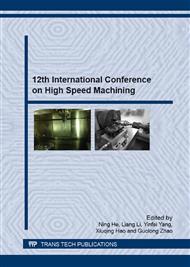p.462
p.468
p.476
p.484
p.493
p.501
p.509
p.522
p.529
Study on the High Speed Cutting Experiment of Micro Deformation Zone Based on the Theory of Dislocation
Abstract:
The dislocation theory is applied to study plastic deformation in high-speed cutting to show the formation characteristics of the micro scale deformation zone in high-speed cutting. Through the quick stoppage experiment of aluminum alloy 7050-T7451 in high-speed cutting and the further research of inclined cutting chip formation mechanism and deformation of shear zone in plastic mechanics and dislocation theory respect .The stress, the strain state and microstructure near the front edge of the rake face edge is analyzed. Effective flow stress, effective strain distribution and variation in shear deformation zone is simulated. According to the experimental and simulation results and from the microscopic respect, the traditional cutting deformation zone is reclassified, the deformation zone of the front edge and dislocations compression zone is increased to achieve a more accurate description of the deformation zone and provide a theoretical basis for the study of high-speed cutting deformation mechanism.
Info:
Periodical:
Pages:
493-500
Citation:
Online since:
January 2016
Authors:
Keywords:
Price:
Сopyright:
© 2016 Trans Tech Publications Ltd. All Rights Reserved
Share:
Citation:


